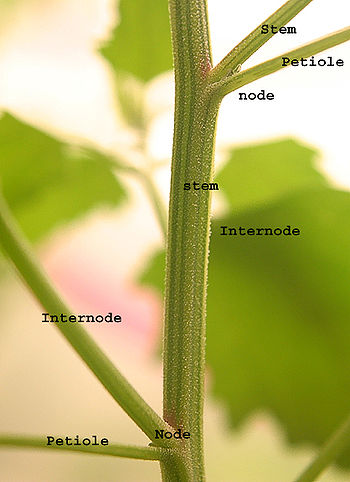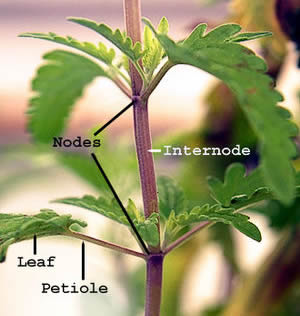Plant Stem
A stem is one of two main structural axes of a vascular plant. The stem is normally divided into nodes and internodes, the nodes hold buds which grow into one or more leaves, inflorescence (flowers), cones or other stems etc. The internodes act as spaces that distance one node from another. The term shoots is often confused with stems; shoots generally refer to new fresh plant growth and does include stems but also to other structures like leaves or flowers. The other main structural axis of plants is the root. In most plants stems are located above the soil surface but some plants have underground stems.Stems have four main functions which are:
» Support for and the elevation of leaves, flowers and fruits. The stems keep the leaves in the light and provide a place for the plant to keep its flowers and fruits.
» Transport of fluids between the roots and the shoots in the xylem and phloem.
» Storage of nutrients.
» The production of new living tissue. The normal life span of plant cells is one to three years. Stems have cells called meristems that annually generate new living tissue.
Contents
» Specialized terms for stems» Stem structure
» Dicot stems
» Monocot stems
» Gymnosperm stems
» Fern stems
» Economic importance
» References
Specialized terms for stems
Stems are often specialized for storage, asexual reproduction, protection or photosynthesis, including the following:» Acaulescent - plants with very short stems that appear to have no stems. The leaves appear to rise out of the ground, e.g. some Viola.
» Arborescent - tree like with woody stems normally with a single trunk.
» Bud - an embryonic shoot with immature stem tip.
» Bulb - a short vertical underground stem with fleshy storage leaves attached, e.g. onion, daffodil, tulip. Bulbs often function in reproduction by splitting to form new bulbs or producing small new bulbs termed bulblets. Bulbs are a combination of stem and leaves so may better be considered as leaves because the leaves make up the greater part.
» Caespitose - when stems grow in a tangled mass or clump or in low growing mats.
» Cladophyll - a flattened stem that appears leaf like and is specialized for photosynthesis, e.g. asparagus, cactus pads.
» Climbing - stems that cling or wrap around other plants or structures.
» Corm - a short enlarged underground, storage stem, e.g. taro, crocus, gladiolus.
» Decumbent - stems that lay flat on the ground and turn upwards at the ends.
» Fruticose - stems that grow shrub like with woody like habit.
» Herbaceous - non woody, they die at the end of the growing season.
» Pseudostem - A false stem made of the rolled bases of leaves, which may be 2 or 3 m tall as in banana
» Rhizome - a horizontal underground stem that functions mainly in reproduction but also in storage, e.g. most ferns, iris
» Runner (plant part) - a type of stolon, horizontally growing on top of the ground and rooting at the nodes. e.g. strawberry, spider plant.
» Scape - a stem that holds flowers that comes out of the ground and has no normal leaves. Hosta, Lily, Iris.
» Stolons - a horizontal stem that produces rooted plantlets at its nodes and ends, forming near the surface of the ground.
» Tree - a woody stem that is longer than 5 meters with a main trunk.
» Thorns - a reduced stem with a sharp point and rounded shape. e.g. honey locust, hawthorn.
» Tuber - a swollen, underground storage stem adapted for storage and reproduction, e.g. potato.
» Woody - hard textured stems with secondary xylem.
Stem structure
Stem usually consist of three tissues, dermal tissue, ground tissue and vascular tissue. The dermal tissue covers the outer surface of the stem and usually functions to waterproof, protect and control gas exchange. The ground tissue usually consists mainly of parenchyma cells and fills in around the vascular tissue. It sometimes functions in photosynthesis. Vascular tissue provides long distance transport and structural support. Most or all ground tissue may be lost in woody stems. The dermal tissue of aquatic plants stems may lack the waterproofing found in aerial stems. The arrangement of the vascular tissues varies widely among plant species.Dicot stems
Dicot stems with primary growth have pith in the center, with vascular bundles forming a distinct ring visible when the stem is viewed in cross section. The outside of the stem is covered with an epidermis, which is covered by a waterproof cuticle. The epidermis also may contain stomata for gas exchange and hairs. A cortex of parenchyma cells lies between the epidermis and vascular bundles.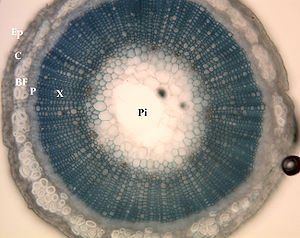
Flax stem cross-section, showing locations of underlying tissues. Ep = epidermis; C = cortex; BF = bast fibres; P = phloem; X = xylem; Pi = pith
Secondary xylem is commercially important as wood. The seasonal variation in growth from the vascular cambium is what creates yearly tree rings in temperate climates. Tree rings are the basis of dendrochronology, which dates wooden objects and associated artifacts. Dendroclimatology is the use of tree rings as a record of past climates. The aerial stem of an adult tree is called a trunk. The dead, usually darker inner wood of a large diameter trunk is termed the heartwood. The outer, living wood is termed the sapwood.
Monocot stems
Vascular bundles are present throughout the monocot stem, although concentrated towards the outside. This differs from the dicot stem that has a ring of vascular bundles and often none in the center. The shoot apex in monocot stems is more elongated. Leaf sheathes grow up around it, protecting it. This is true to some extent of almost all monocots. Monocots rarely produce secondary growth and are therefore seldom woody. However, many monocot stems increase in diameter via anamolous secondary growth.Gymnosperm stems
All gymnosperms are woody plants. Their stems are similar in structure to woody dicots except that most gymnosperms produce only tracheids in their xylem, not the vessels found in dicots. Gymnosperm wood also often contains resin ducts. Woody dicots are called hardwoods, e.g. oak, maple and walnut. In contrast, softwoods are gymnosperms, such as pine, spruce and fir.Fern stems
Most ferns have rhizomes with no vertical stem. The exception is tree ferns, with vertical stems up to about 20 meters. The stem anatomy of ferns is more complicated than that of dicots because fern stems often have one or more leaf gaps in cross section. A leaf gap is where the vascular tissue branches off to a frond. In cross section, the vascular tissue does not form a complete cylinder where a leaf gap occurs. Fern stems may have solenosteles or dictyosteles or variations of them. Many fern stems have phloem tissue on both sides of the xylem in cross-section.Economic importance
There are thousands of species whose stems have economic uses. Stems provide a few major staple crops such as potato and taro. Sugar cane stems are a major source of sugar. Maple sugar is obtained from trunks of maple trees. Vegetables from stems are asparagus, bamboo shoots, cactus pads or nopalitos, kohlrabi, and water chestnut. The spice, cinnamon is bark from a tree trunk. Cellulose from tree trunks is a food additive in bread, grated Parmesan cheese, and other processed foods. Gum arabic is an important food additive obtained from the trunks of Acacia senegal trees. Chicle, the main ingredient in chewing gum, is obtained from trunks of the chicle tree.Medicines obtained from stems include quinine from the bark of cinchona trees, camphor distilled from wood of a tree in the same genus that provides cinnamon, and the muscle relaxant curare from the bark of tropical vines.
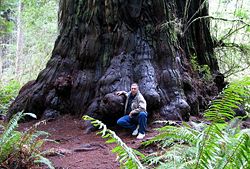
The trunk of this redwood tree is its stem.
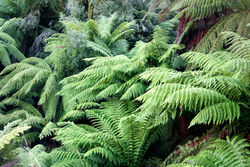
Tasmanian tree fern
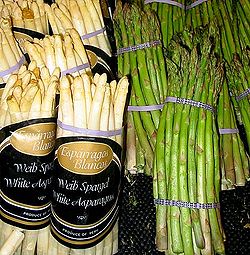
White and green asparagus - crispy stems are the edible parts of this vegetable
Wood is a used in thousands of ways, e.g. buildings, furniture, boats, airplanes, wagons, car parts, musical instruments, sports equipment, railroad ties, utility poles, fence posts, pilings, toothpicks, matches, plywood, coffins, shingles, barrel staves, toys, tool handles, picture frames, veneer, charcoal and firewood.
Wood pulp is widely used to make paper, cardboard, cellulose sponges, cellophane and some important plastics and textiles, such as cellulose acetate and rayon. Bamboo stems also have hundreds of uses, including paper, buildings, furniture, boats, musical instruments, fishing poles, water pipes, plant stakes, and scaffolding. Trunks of palm trees and tree ferns are often used for building. Reed stems are also important building materials in some areas.
Tannins used for tanning leather are obtained from the wood of certain trees, such as quebracho. Cork is obtained from the bark of the cork oak. Rubber is obtained from the trunks of Hevea brasiliensis. Rattan, used for furniture and baskets, is made from the stems of tropical vining palms. Bast fibers for textiles and rope are obtained from stems include flax, hemp, jute and ramie. The earliest paper was obtained from the stems of papyrus by the ancient Egyptians.
Amber is fossilized sap from tree trunks; it is used for jewelry and may contain ancient animals. Resins from conifer wood are used to produce turpentine and rosin. Tree bark is often used as a mulch and in growing media for container plants.
Some ornamental plants are grown mainly for their attractive stems, e.g.:
» White bark of paper birch
» Twisted branches of corkscrew willow and Harry Lauder's walking stick (Corylus avellana 'Contorta')
» Red, peeling bark of paperbark maple
